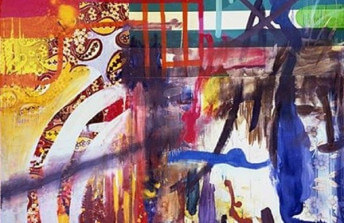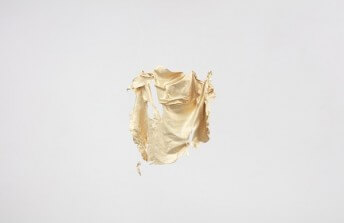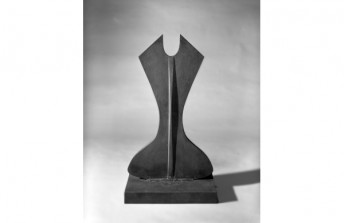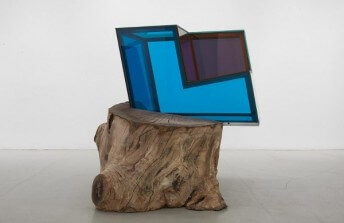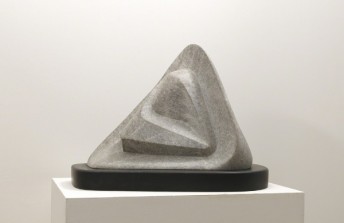Why Jackie Winsor is Eccentrically Abstract
Apr 19, 2019
The work of Jackie Winsor provides a perfectly wonderful foil to academic theories about contemporary abstraction. The debate that drives most current conversations about abstract art inevitably revolves around the difference between pure abstraction—art that has no relation at all to the so-called real world—and abstraction that is derived from, or abstracted from, something figurative. For more than five decades, Winsor has been making works that could, in theory, fit into either side of this debate. For example, the uncanny presence of “Chunk Piece” (1970), a rolled up, hemp log, could be considered something abstracted from the real world, despite the fact that nothing just like it exists in reality. Meanwhile, “Pink and Blue Piece” (1985), a mirrored cube, could be called pure formalist abstraction, since it is but a simple, geometric form resting in space. Yet both of these works could also be described in countless other ways. The supposedly formalist cube could be figurative, since it resembles numerous other objects in the real world; and the supposedly abstracted log may not be abstract at all—it may be a concrete, self-referential object that exists for no reason other than to express its own qualities. So eccentric and individualistic are the sculptures Winsor makes that they completely unravel the abstraction debate. They exist outside of the conversation, rendering it irrelevant. Yet they are so convincing on a visceral level—so sublimely declarative of something essential, but beyond our intellect—that I cannot help but think they are essential to our understanding of abstraction. Like two other visionaries of her generation—Richard Serra and Eva Hesse—Winsor represents the promise that abstract art can simultaneously be unimaginably esoteric, and undeniably human.
To Stubbornly Exist
In 1979, at the age of 37, Winsor was given a solo exhibition at the Museum of Modern Art in New York. The exhibition featured 24 works. In the catalogue essay for the show, Winsor was described as “one of today's most accomplished younger sculptors.” The essay does not, however, provide much clarity as to what it is exactly that made the curators think the work Winsor does was so important. Avoiding all hyperbole, it simply points out about the work “its object-ness or, as Ellen Johnson, quoting Rilke, puts it, its ‘stubborn existence.’” The pieces in the MoMA exhibition shared a universal quality best described as being communicative of meticulous, drawn out effort: they were evidence of work. “Bound Square” (1972) looks as basic as a simple wooden frame, but the miles of twine wrapped around its corners belies the fact that Winsor sat for innumerable hours methodically binding the piece together. “Four Corners” (1972) is a simple arrangement of four round forms on the floor, but how many hours went into rolling the balls into shape? Likewise, the countless nails driven into the wooden top of “Nail Piece” (1970) suggest a manic quality, while the self-referentially titled “30 to 1 Bound Trees” (1971-72) seems to interrogate the value of all human work in relation to nature.
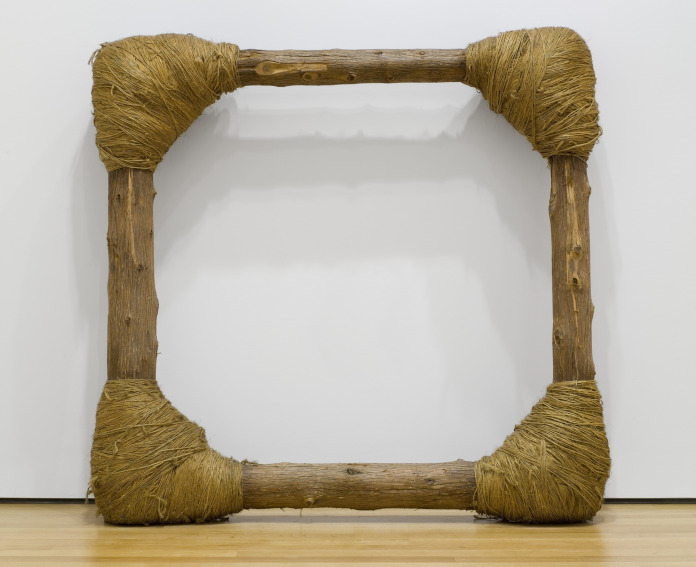
Jackie Winsor - Bound Square, 1972. Wood and twine. 6' 3 1/2" x 6' 4" x 14 1/2" (191.8 x 193 x 36.8 cm). Joseph G. Mayer Foundation, Inc., in honor of James Thrall Soby and Grace M. Mayer Fund in honor of Alfred H. Barr, Jr. MoMA Collection. © 2019 Jackie Winsor
The first reaction one might have when encountering sculptures like “Bound Square,” “Four Corners,” “Nail Piece” and “30 to 1 Bound Trees” is to admire the abstract simplicity of the forms. Perhaps secondly one might feel a visceral attraction to the raw physicality of the materials—the wood, the hemp, and the metal. But it is in the process of finally imagining the effort that went into the creation of the sculptures that our human connection to those forms and those materials reaches its apex. It is then that we realize that the simple geometric forms were not chosen only for their formal abstract qualities, but because they most lend themselves to repetitive, monotonous work. Imagining the feeling of holding the wood and hemp and hammer and nails in our hands hour after hour connects the sculptures to our flesh and blood humanity. The pieces indeed stubbornly exist despite our ability to describe them, validate them, or assign them meaning; they also stubbornly occupy intellectual territory, celebrating with their existence the inherently beautiful but confounding nature of all effort.
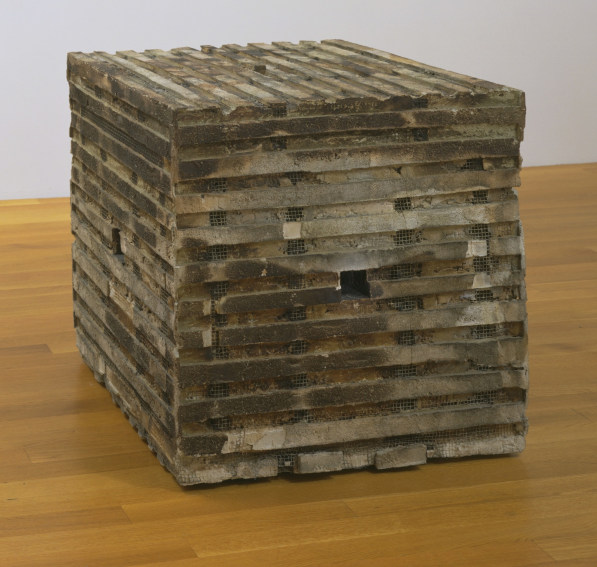
Jackie Winsor - Burnt Piece, 1977-78. Cement, burnt wood, and wire mesh. 33 7/8 x 34 x 34" (86.1 x 86.4 x 86.4 cm). Gift of Agnes Gund. MoMA Collection. © 2019 Jackie Winsor
The End of Labels
One of the more dubious labels that has frequently been assigned to Winsor is “Process Art,” which is a way of describing aesthetic phenomena for which the end object is not important—it is the process of creation that matters the most. What confuses people, no doubt, about Winsor is that process is so obviously vital to her creations. Indeed, nothing she makes could come about without her inventing often entirely new processes, which incorporate novel methods and techniques specific, perhaps, only to the creation of one particular sculpture. As important as her processes are, however, the end object remains vital. Yes, it is the result of the process, and the validation of the process, but it is also the raison d’etre of the process. Without the vision Winsor had for an object, stubbornly existing in real space and time, the process would have no reason to exist.
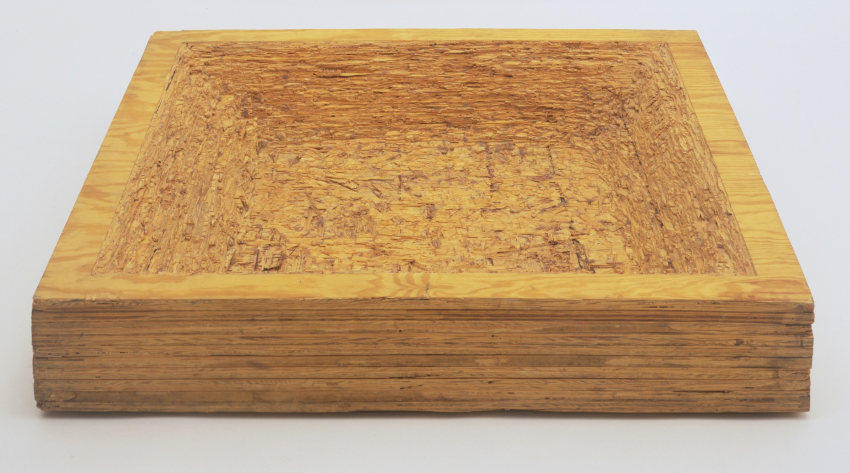
Jackie Winsor - Laminated Plywood, 1973. Plywood. 7 1/2 x 48 x 48" (19.1 x 121.9 x 121.9 cm). Gift of the Gilman Foundation in memory of J. Frederic Byers III. MoMA Collection. © 2019 Jackie Winsor
Another Label frequently assigned to Winsor is Post-Minimalism. This label, as well, has little bearing on her work. Post-Minimalist art uses Minimalism as a starting point, or a reference point, but does not embrace all of its conceptual beliefs. Winsor stands apart from this muddled description, and all other half-baked labels. Like Marcel Duchamp, she is a one-woman art movement. She brings sculptures into existence that speak confidently about what it means to have a presence; to contain texture; to occupy space; to be the result of work. She makes art that declares that it has as much right to be here as any rock or tree or creature. Her sculptures do not need to be validated by theory, or explained academically, in order for to claim heir agency. They free us from having to categorize, or even understand. All we need to do to appreciate her work is simply appreciate it for what it undeniably is: concrete; abstract; esoteric; eccentric; and human.
Featured image: Jackie Winsor - Chunk Piece, 1970. Hemp. 36 x 38 in. (91.4 x 96.5 cm). Paula Cooper Gallery. © Jackie Winsor
All images used for illustrative purposes only
By Phillip Barcio

